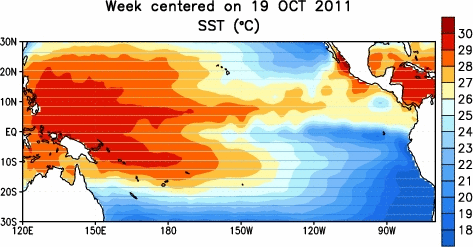
We seem to have settled into a moderate to strong El Niño. NOAA’s latest weekly update on the El Niño/Southern oscillation, “ENSO Cycle: Recent Evolution, Current Status and Predictions“ shows that the key region of the Pacific Ocean has stayed quite warm for all of November (see here for figures and data).
The question is how long it will stay fairly strong. Last week I noted that NOAA’s Climate Prediction Center had asserted:
Based on current observations and dynamical model forecasts, El Niño is expected to continue to strengthen and last through at least the Northern Hemisphere winter 2009-10.”
This week they tweaked that to say:
Based on current observations and dynamical model forecasts, El Niño is expected to last through at least the Northern Hemisphere winter 2009-10.
Today’s report notes:
Nearly all ENSO models indicate El Niño will continue through the Northern Hemisphere winter 2009-10. The models disagree on the eventual strength of El Niño, but a majority indicate at least a moderate strength El Niño (greater than +1.0°C) through December-January-February 2009-10.
A majority of ENSO models indicate El Niño will continue through March-April-May 2010.
Last week, NOAA said its own CFS (Climate Forecast System) ensemble mean forecast “predicts El Niño will last at least through Northern hemisphere spring 2010.”
This week, the prediction is slightly different:
Summer 2010 is a long way off to make an ENSO prediction. Next week, NOAA will release its monthly analysis, which should give a clearer picture of what the expert NOAA forecasters think is likely to happen next year.
Back in January, NASA had predicted: “Given our expectation of the next El Niño beginning in 2009 or 2010, it still seems likely that a new global temperature record will be set within the next 1-2 years, despite the moderate negative effect of the reduced solar irradiance.”
We’re at “the deepest solar minimum in nearly a century,” and this is the hottest decade in recorded history by far, but it looks like NASA’s prediction is on track.
Related Post:
- Skeptical Science explains how we know global warming is happening: It’s the oceans, stupid!
- Another major study predicts rapid warming over next few years — nearly 0.3°F by 2014
- Must-read AP story: Statisticians reject global cooling; Caldeira — “To talk about global cooling at the end of the hottest decade the planet has experienced in many thousands of years is ridiculous.”


